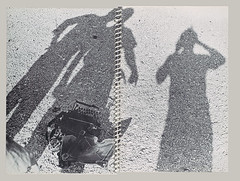Best of all, the Thunderbird, just like the Ballard short story, has an actual poetry-generating machine available for the use of guests. I borrowed it the last night, head filled with fresh aesthetic alterations from the West Texas moonscape, and figured out how to make it work, cranking out otherworldy missives to friends. I liked it so much that, when I returned home, I searched for one just like it. And found it. $7.00 on eBay.

The manual typewriter is a green machine of irrevocable text for an age of electrified malleability. It does not make any noise other than the pretty punchy cinema newsroom sound of the keys hitting the paper as you type. It promotes a careful selection of words. It promotes brevity. When you stop to think, it does not whir like the fan on the roof of an office building or crackle like an electric popcorn machine. Just the silence of your own thoughts. The only hard drive the soft wet fallible one between your ears.
Find yourself one, write a letter to someone you care about, and you will see what I mean. They are easy to find. The trick is finding the ribbons, but most towns of any size usually have one weird shop where some grizzled ostiary in lab coat maintains an inventory and the ability to jury rig a fit.
There are a few writers who still use them exclusively. Well, at least there's Howard Waldrop, who transforms the vintage courier font into a mind-blowing hieroglyphic. For a while, he was even blogging on a typewriter. Ask Eileen.
Careful, though. As Thomas Jones insightfully notes in the May 10 issue of London Review of Books, if you go there you need to avoid the potential film noir self-delusion:
"There is a wearisome machismo inherent in much of the iconography of typewriting. In The Iron Whim: A Fragmented History of Typewriting (Cornell, £15.95), Darren Wershler-Henry describes the typewriter as ‘the symbol of a non-existent sepia-toned era when people typed passionately late into the night under the flickering light of a single naked bulb, sleeves rolled up . . . lighting each new cigarette off the smouldering butt of the last, occasionally taking a pull from the bottle of bourbon in the bottom drawer of the filing cabinet’. Replace that evasive ‘people’ with ‘men’, and the fantasy’s spot on.
"The Iron Whim (the title comes from a phrase of Marshall McLuhan’s) begins with an account of the making of Ed Ruscha’s Royal Road Test. On the afternoon of Sunday, 21 August 1966 – the year before my father’s typewriter was made – Ruscha drove a 1963 Buick Le Sabre at 90 miles an hour along Highway 91 through the Nevada desert. Shortly after five o’clock, the writer Mason Williams rolled down the passenger window, and threw out a Royal Model X typewriter. Patrick Blackwell photographed the results.
"Although Wershler-Henry devotes twenty pages or so to ‘the typewriter girl’ and ‘Remington priestesses’, and notes that between 1870 and 1930, the female proportion of typists in America soared from 4 per cent to 95.6 per cent, the bulk of The Iron Whim concerns itself with the likes of Paul Auster, Bram Stoker, William Burroughs, David Cronenberg, Mark Twain, Jack Kerouac, Truman Capote, Norman Mailer, J.G. Ballard and Hunter S. Thompson: in other words, men. He says more than once that he’s less interested in typewriters as machines (once upon a time the word also referred to the people, usually women, who used the machines) than in typewriting as discourse. But this is typewriting as it appeals to geeks who like guns: all those dates and serial numbers; all that metal. Incidentally, or not so incidentally, the first mass-produced typewriter, as Wershler-Henry notes, was made by a gun manufacturer, E. Remington and Sons. And the Tommy gun, invented by a one-time Remington engineer, John Taliaferro Thompson, was known during prohibition as the ‘Chicago typewriter’."
Though I have to say, the idea of throwing a typewriter from the window of a '63 Buick blowing down a Nevada highway is pretty fucking cool. Suggestions for a next generation homage are welcome.

(Thanks to the ever-erudite Tim Chapman at the JGB listserv for the LRB link.)
Next gen homage:
ReplyDeletehucking a laptop from a city bus as it crosses from the urban to the suburban side of town.
Nice! Or maybe hurled from an airliner in flight over some endless exurbia, after opening the door on the exit row...
ReplyDelete